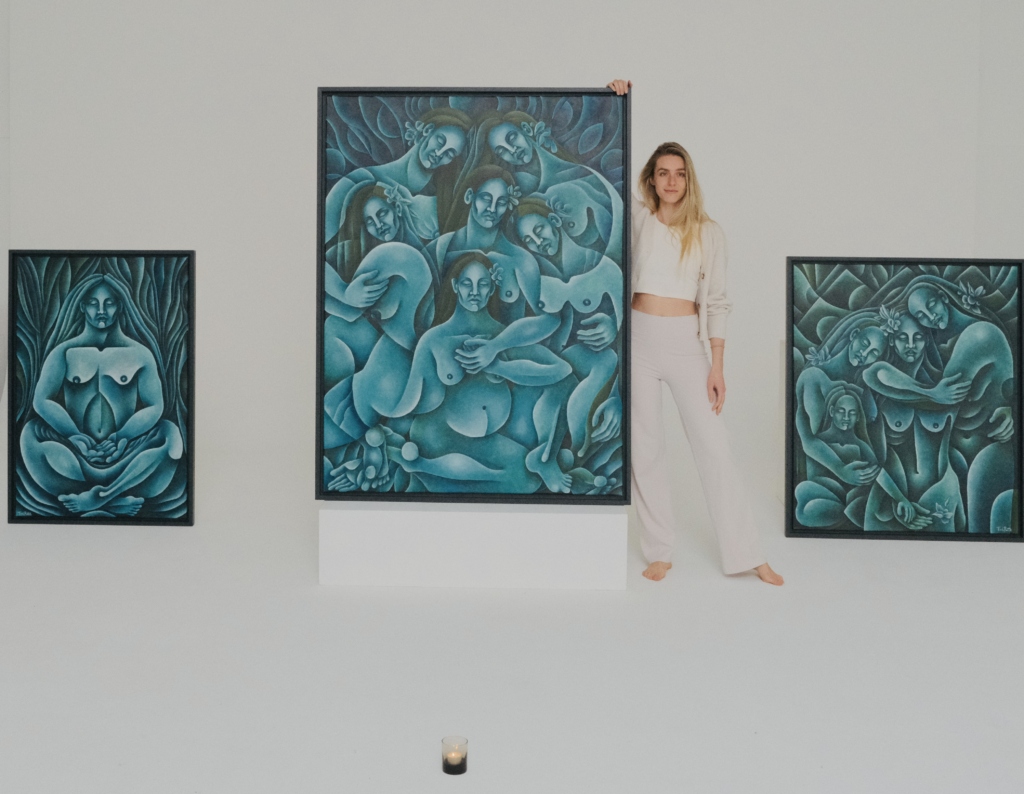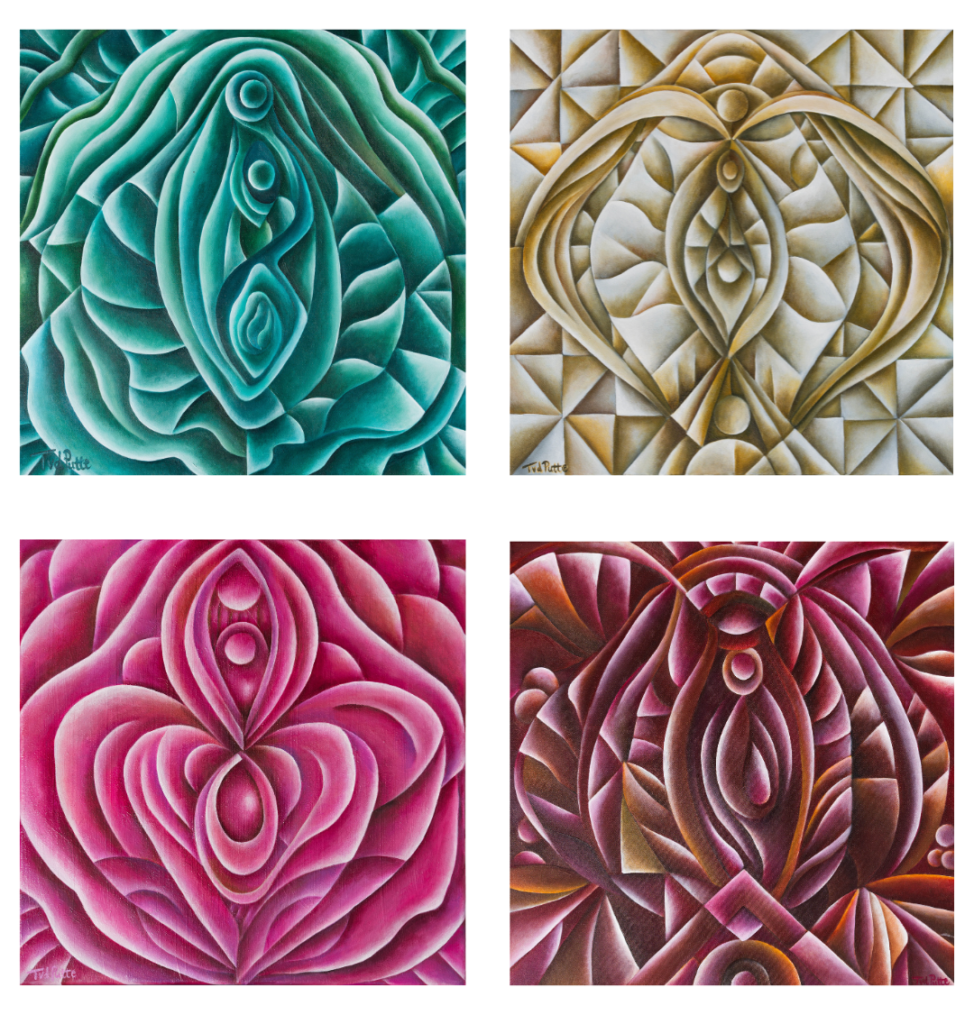Throughout the ages, humanity has looked to the cosmos for guidance, intricately weaving the natural world into the fabric of daily life. Elements like trees, with their life-sustaining presence from sapling to ancient grove, have played a pivotal role in this connection. Tessel van der Putte’s recent exhibition, Root to Rise, eloquently explores our deep relationship with nature through an eco-feminist lens. She draws on the profound symbolism of growth and resilience, mirroring life’s journey from its hidden beginnings beneath the soil to its ascension into the light. For example in the “Vulva Series” one sees a particularly striking and bold artistic statement that aligns the often-hidden, stigmatized aspects of the female form with the unseen roots of plants. Van der Putte suggests that just as roots anchor and nourish what grows above, the overlooked parts of our being are essential to our vitality and growth.
Inspired by the surrealist visions of Remedios Varo and the transformative sculptures of Wangechi Mutu, van der Putte’s art not only pays homage to these pioneering figures but also forges a path towards a more harmonious and sustainable relationship with our environment and with each other. Her work is a call to see beyond the surface, to understand the deep connections we share with the natural world, and to cultivate reverence for these relationships.
In conversation with van der Putte
- ‘Root to Rise’ emphasises the connections between humans and nature. What message do you hope viewers take away from this collection?
In Root to Rise I draw inspiration from the resilience and grace of trees. Trees root deeply and rise skyward, symbolising personal growth and grounding in our true nature. Throughout the seasons, trees remain steadfast and genuine, never pretending to be anything other than what they are. I’ve always seen trees as silent witnesses to our lives, outlasting us and standing as symbols of continuity and transformation.
Trees feature prominently in many spiritual and religious narratives. For example, the Buddha found enlightenment under a Bodhi tree; Yggdrasil, the Norse World Tree, connects different realms; and the tree of knowledge in Christian mythology symbolises profound human experiences. These stories highlight the powerful relationship between human transformation and trees.
Through “Root to Rise,” I hope to help viewers transcend feelings of rigidness and separation. This applies not only to how we perceive our bodies and gender expressions but also to how we connect deeply with the natural world inside us. Growing up, I often felt out of place in social settings. Instead of seeking external validation, I’ve learned to find grounding within myself—to ‘root’ before I ‘rise.’
This process of growth and connection is continuous and cyclical. By embracing vulnerability, we can bridge the uncomfortable spaces within and realise that many people struggle to find their place in a fast-paced, chaotic world. Like the interconnected network of tree roots, humans naturally seek and create connections. Our society, however, often promotes values of efficiency and individualism over patience, imperfection, and authentic expression. Through my paintings, I strive to create space for these qualities, providing a visual and emotional sanctuary for viewers to find their place as they journey through life.

- How has your background in human rights and climate change studies influenced your artistic career and approach to projects such as ‘Root to Rise’ or ‘Body Currents’?
My studies in human rights and climate change deeply influence my art. Each painting weaves together themes related to the (female) body, environmental consciousness, and the emotional landscapes in between. My research has heightened my awareness of sensitive, underrepresented issues, particularly concerning the female body and autonomy. Female voices are deeply intertwined with climate change, environmental degradation, and the impacts of pollution on our ecosystems. Weaving in narratives that highlight the importance of empathy, care, and connection in projects like ‘Root to Rise’ and ‘Body Currents’ celebrates a more fluid, and feminine experience on these matters. I hope that projects like ‘Root to Rise’ and ‘Body Currents,’ can showcase the resilience and strength found in both nature and the feminine experience, emphasising the importance of nurturing and protecting both.

- How does ‘Root to Rise’ discuss eco-feminist perspectives and themes around body autonomy?
The ‘Vulva Series’ is a significant part of Root to Rise. These colourful, abstract paintings celebrate the vulva, depicting it as oysters, flowers, sandy landscapes underwater, or seeds and soil. Placing these works alongside the tree series emphasises the raw, natural, and unfiltered lens through which I view both the human body and the natural landscape. By drawing connections between natural elements such as flowers, oysters, seeds, soil, and riverbeds to the female body, the artworks celebrate aspects that are often concealed.
This project began two years ago with the intention of shedding light on a part of the human body that is often hidden and stigmatised. Inspired by artists like Georgia O’Keeffe and informed by women’s rights advocacy, I wanted to start a sensitive yet crucial discussion about our connection to our bodies and bodily autonomy. In many cultures, the female body is considered shameful and hidden. Even medical research related to wombs, menstruation, and pleasure is underrepresented and taboo.
Shame surrounding the female body is pervasive, affecting women from childhood through old age. The female body and the vulva deserve more recognition and celebration—they are gateways to life, where all humans originate. Through my work, I aim to elevate these often-overlooked aspects of our being, highlighting their beauty and importance in the natural world.
- How do you understand the term “progress,” and how has your understanding of different cultures shaped this concept in your work?
The term “progress” often brings to mind notions of economic growth and linear advancement, driven by a desire to become “bigger and better.” This conventional view reflects our capitalist lifestyles and economic models, prioritizing measurable achievements and power while neglecting our emotional worlds and the natural environment. These aspects of life are intricate, cyclical, and defy linear measurement, requiring patience and sensitivity to engage with.
For me, progress should encompass qualities like relatability, connectivity, nurture, and care—attributes inherent to nature. We should visualize progress in more creative, cyclical, and organic forms in our daily lives. This perspective is influenced by my interest in Indigenous cultures, Tibetan Buddhism, Shinto philosophy, and other non-linear spiritual traditions. These philosophies emphasize compassion, patience, and the interconnectedness of life, challenging rigid structures of thought and encouraging me to think outside the box.
Art plays a crucial role in reimagining progress. It helps us envision more connected and holistic worlds, transcending the limitations of conventional progress. Artists like Remedios Varo, Hilma af Klint, and Wangechi Mutu inspire me with their exploration of spirituality, time, and life’s interconnectedness. Their work provides a rich source of inspiration for my art, encouraging a more harmonious and sustainable relationship with the environment and each other.
- Is there art in everyday life? Can you point out examples around us right now? How does this influence your work?
Art is everywhere in everyday life. Wherever you are reading this, take a moment to breathe deeply and observe your surroundings. Notice how the light reflects on the floor, how tree shadows dance on the street, or how water moves and distorts reflections. The biggest artist of all is nature itself.
Before starting my work, I often take a mindful walk in the forest near my studio. This practice clears my thoughts and sets my intentions. Observing the natural world—the way light awakens the day, how water reflects colors, and how it distorts or mirrors its surroundings—fills me with awe. These observations ground me and connect me to nature, providing inspiration and energy for my creative process.
Water is a significant element of inspiration in my art. I’m fascinated by how water shapes and connects forms, and its color transitions from deep shadows to light hues. This influence led me to create round paintings that can be viewed from different angles, illustrating the fluidity of perspective and the ever-changing dance of elements. Each piece reflects the interconnectedness of bodies and the environment, reminding us of our place within the natural world. For example, my works like Capillary Waves, Ebb & Tide, and Ouroboros explore these themes. I often merge the boundaries of bodies and the environment in my art, visualising a shared growth and connection.

- Do you believe in the concept of art as a healing process? How does this idea reflect in your own creative journey?
Absolutely, art holds profound transformative power. For me, it has been a sanctuary and a medium for deep introspection and healing. From a young age, being highly sensitive and often overwhelmed by the chaos of the world, creating art provided me with a way to calm down, recharge, and re-centre myself. This process allowed me to navigate and make sense of my emotions and the world around me.
Art has a unique ability to bypass the analytical mind and speak directly to the heart, expressing feelings that words often fail to capture. This universality of art’s healing power means it resonates deeply on a personal level. It’s a way to shift perspectives and find peace in the midst of turmoil. Through my creative journey, I’ve come to see art not just as a form of expression but as a means to connect deeply with my inner self and heal from within.
- Future directions: How do you see your work contributing to the broader conversations around environmentalism and feminism?
Looking ahead, I aspire to continue contributing to conversations around environmentalism and feminism through my art. Water, in particular, is a recurring theme in my work, symbolizing both emotional and environmental connections. By blending elements of water and femininity, I aim to foster a deeper awareness and appreciation for the natural world.
As an artist, I am committed to exploring sustainable practices in my work. This includes using recycled materials, such as canvas made from plastic bottles, and incorporating organic materials into my paintings. I am also interested in integrating more plant and water installations into my future exhibitions.
Furthermore, I want to merge my research and storytelling more tangibly with my art. This involves creating projects that narratively explore personal histories, local memories, and stories about water. By doing so, I hope to paint a vivid picture that connects people more deeply with the environment and with each other.
In essence, my goal is to use art as a tool to visualize and promote a more connected and holistic vision of progress. Whether through the materials I use or the stories I tell, I seek to inspire a collective journey towards a more sustainable and compassionate world. As my father-in-law wisely says, “If you want to go fast, go alone; if you want to go far, go together.” This ethos applies to trees, to humans, and to the art we create.
End of Interview
Through these exhibitions, van der Putte doesn’t just present nature as a backdrop to human experience but elevates it to a vital, dynamic force deserving of our deep respect and introspection. Her work serves as a poignant reminder of the interconnectedness of all life and the importance of nurturing our connection with the earth.
*
‘Root to Rise’ by Tessel van der Putte, curated by Natasha Grant, is currently exhibiting at Toqueur, an art gallery and creative hub showcasing talented emerging artists. It is located in the heart of Westerpark, Amsterdam.

Our mascot writes all ALMA Staff pieces. ORI is whimsical and unpredictable; we’ve tried being friends with him and failed.


